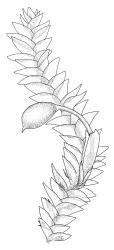- = Aulacopilum Wilson
The generic description takes elements from several literature sources, including Stone (1997, p. 486), Crum (1973), and Brotherus (1925).
Plants small and slender, complanate or terete, forming loose or dense mats on bark or rocks. Stems creeping, irregularly branched, bearing smooth, usually sparse, rhizoids in clusters on lower surface, in cross-section with or without a central strand. Branches horizontal or ascendant, often very short. Leaves similar on stems and branches, ecostate, either uniform and terete or dimorphic, complanate, and in two dorsal rows that obscure two small ventral rows, oblong-lanceolate to oblong-ovate or elliptic, rounded to acuminate at apex and sometimes with a hair-point, unbordered, entire or crenulate at margins. Laminal cells hexagonal, subquadrate, or rhombic, sometimes bulging, pluripapillose or smooth, usually oblate in lower leaf and/or at margins; alar cells not differentiated.
Autoicous. Perichaetia terminal on short branches; perichaetial leaves erect and sheathing. Perigonia often gemmiform, scattered on stems and branches. Setae short and ± straight; capsules erect, symmetric, immersed to exserted, oblong- to ovoid-cylindric or obovoid, often with a prominent columella, pale and rather thin-walled, scarcely wrinkled when dry; exothecial cells mostly thin-walled; stomata usually present and superficial (absent in N.Z. taxon); annulus present or none; operculum low conic or nearly flat, apiculate or rostrate. Peristome mostly absent or, if present, consisting of 16 lanceolate or rudimentary papillose teeth. Calyptra mitrate or sometimes becoming split on one side, long or short, usually plicate, sometimes twisted, smooth or papillose. Spores green, variable in size, papillose or rarely nearly smooth.
The nomenclatural history of the generic name Erpodium is complex and beyond the scope of this Flora. I have elected to follow the nomenclature employed by Stone (1997) who, in turn, accepted the nomenclatural interpretation and the detailed supporting arguments presented by Crum & Anderson (1981, p. 674). Stone cited the generic authorship as Erpodium (Brid.) Müll.Hal. Her interpretation contrasts with that presented by Missouri Botanical Garden (2013, accessed 10 Dec. 2013).
Stone’s (1997) arguments in favour of placing all the Australian species (including the single N.Z. species) of Erpodiaceae in Erpodium (rather than some in segregate genera) are also accepted here. Stone provided descriptions, illustrations and a key to the six species of Erpodium recognised from Australia; this provided the basis for the unillustrated account of the family in the Flora of Australia (Stone 2006). Stone (1997, p. 486) suggested that the genus, as circumscribed by her, could be divided into two groups based on gametophytic characters. The characters she used are primarily the presence of dimorphic 4-ranked leaves and complanate stems vs uniform, unranked leaves and terete stems; the presence/absence of a central strand, and the nature of laminal cell ornamentation. The one species occurring in N.Z. has dimorphic and 4-ranked leaves.
Crum (1973) presented an alternative interpretation of the genera in this family, based on a worldwide review. He treated the single N.Z. representative in Aulacopilum, as was done by Brotherus (1925, p. 5), Sainsbury (1955) and Fife (1995). Crum (p. 205) distinguished Erpodium s.s. from Aulacopilum on the basis of calyptra form, size, and degree of twisting. Goffinet et al. (2009) also recognised five genera in the family (all of which were considered to be synonyms of Erpodium by Stone (1997)). The late Ron Pursell was working on a monograph of the Erpodiaceae at the time of his death in March 2014.
A genus of c. 24 species occurring in tropical and warm-temperate regions worldwide. Occurring mainly on tree trunks but also on rock.
| Category | Number |
|---|---|
| Indigenous (Non-endemic) | 1 |
| Total | 1 |
The great rarity and widely scattered occurrence of many species of Erpodium, and the genus as a whole, suggest this is an ancient genus and that the current species distributions are relictual.




